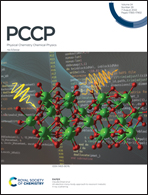Chemical reactions of graphitic carbon nitride films with glass surfaces and their impact on photocatalytic activity†
Abstract
Thin films of graphitic carbon nitride (g-CN), a visible-light-driven photocatalyst, have recently attracted interest for application in photoelectrochemical cells for water splitting and high-throughput photocatalysis. In typical syntheses, g-CN films are formed by heating the nitrogen-rich precursor and substrate to 500–600 °C. The heated substrate should affect the polycondensation of the precursor and thereby alter the properties of the g-CN film. In this paper, we demonstrate that soda-lime glass, such as commercial glass slides, modifies the chemical structure of g-CN. The terminal amino groups of g-CN are partially substituted with cyanamide and hydroxyl groups. The electron-withdrawing groups provide the energy offsets of the frontier orbitals between the modified and unmodified molecules, facilitating exciton dissociation. After alkali metals are removed, the modified g-CN film exhibits a faster photodegradation of methyl orange compared with a melon film. The simple protocol to activate a g-CN film without co-catalysts paves a new way to enhance photocatalytic activity via selections of substrates, including waste glass.

- This article is part of the themed collection: 2022 PCCP HOT Articles


 Please wait while we load your content...
Please wait while we load your content...